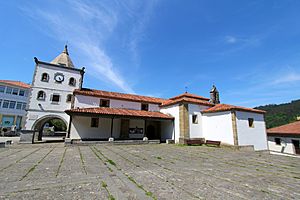Iglesia de Santa María (Soto de Luiña) facts for kids
Quick facts for kids Iglesia de Santa María (Soto de Luiña) |
|
|---|---|
 |
|
| Religion | |
| Ecclesiastical or organizational status | Church |
| Location | |
| Location | Cudillero (Asturias), Spain |
| Type | Cultural |
| Criteria | ii, iv, vi |
| Designated | 1993 (17th session) |
| Parent listing | Routes of Santiago de Compostela: Camino Francés and Routes of Northern Spain |
| Reference no. | 669bis-014 |
| Region | Europe and North America |
| Type | Non-movable |
| Criteria | Monument |
| 28 November 1996 | |
| RI-51-0009584 | |
The Iglesia de Santa María (Soto de Luiña) is a beautiful church located in Soto de Luiña, a town in Cudillero, Asturias, Spain. It was built in the 18th century. This church, along with the nearby Rectory House, was once part of an old hospital for pilgrims. These pilgrims were travelers on the famous Camino de Santiago, also known as the Way of St. James.
The church was built on the site of an even older chapel or hermitage. This earlier building was located near a spring, which people believed had a special, almost magical, quality.
Church Design and Features
The church has a special shape called a Latin cross. This means it looks like a cross when you view it from above. It has three main sections, called naves, and three smaller chapels.
At the back of the church, there is a rounded area called a semicircular apse. At the front, there is a tall, square tower made of grey stone. The tower has plain walls and three levels. You can see semicircular arches and special carved spaces called niches, made of stone and wood.
The side entrances, or porticos, are held up by strong columns. The tower ends with an eight-sided top made of large, cut stones. On the corners of the tower, there are interesting gargoyles shaped like animals.
Building History
The first part of the church to be built was the tower. It was designed by a master builder named Domingo Fernández. Around the same time, the Main and Rosary chapels were constructed. Pedro García finished this part of the work.
Later, after some disagreements with the town, the Saint Inés chapel was added. Don Lope Matías Menéndez de Luarca y Tiena was responsible for building it. By the middle of the 18th century, the main central part of the church was completed. This included its arches, doors, and windows.
Art and Treasures
Inside the church, you'll find several beautiful altarpieces. The main altarpiece is in the Baroque style, which is very decorative. It was likely created by José Bernardo de Mena. This altarpiece is dedicated to Our Lady of Humility and features sculptures by Antonio Baroja, an artist from Asturias.
On the right side, there is the Rosary altarpiece. It shows the "Tree of the Life of Jesus," which is a way of illustrating Jesus's family history. On the left, you'll find the Saint Agnes altarpiece. This one shows the "Tree of the Birth of Jesus," also representing his family tree.
Above the main entrance door, there is an inscription carved into the stone. It simply says: YEAR 1782 ASYLUM CHURCH
The church was carefully restored in 1984. After this work, it was officially recognized as an artistic-historic monument.
Among the valuable items inside the church, a silver Processional Cross stands out. It was made in 1609 and is thought to be the work of Juan de Nápoles Mudarra, a skilled goldsmith from Valladolid. This cross is considered to be of excellent quality and one of the best in Spain. The church also has a silver monstrance from the 17th century. A monstrance is a special container used to display the Eucharist. There is also an important collection of old documents from the 17th century.
See also
 In Spanish: Iglesia de Santa María (Soto de Luiña) para niños
In Spanish: Iglesia de Santa María (Soto de Luiña) para niños

